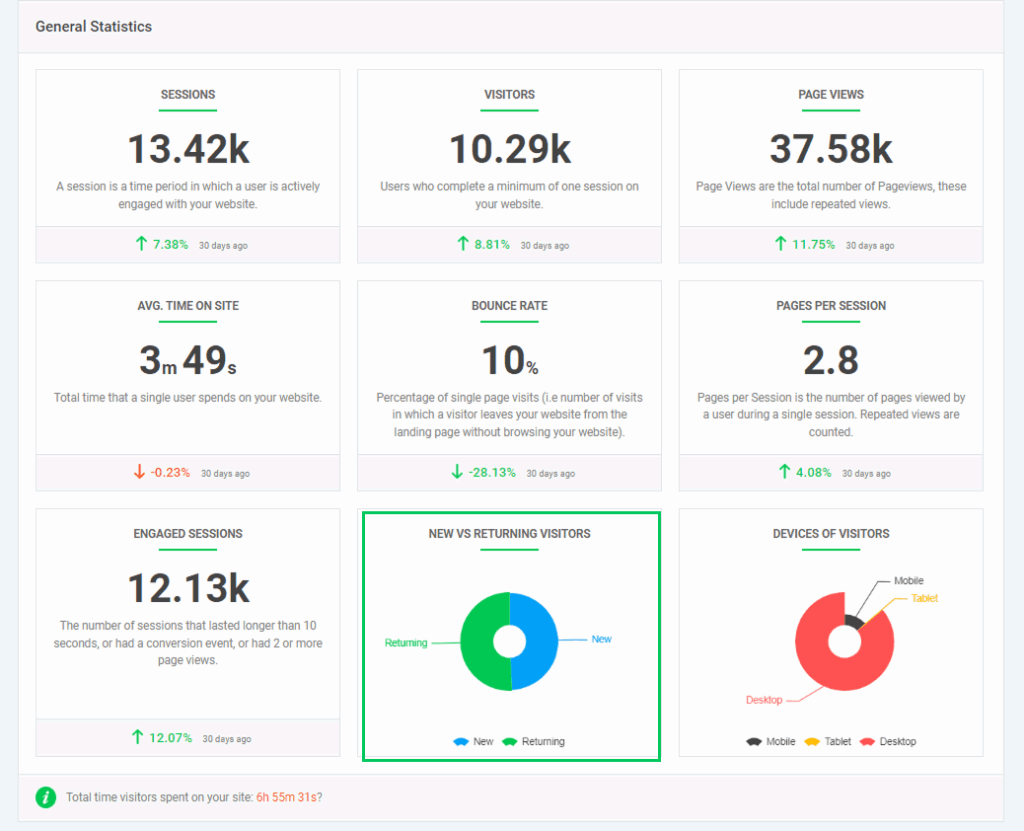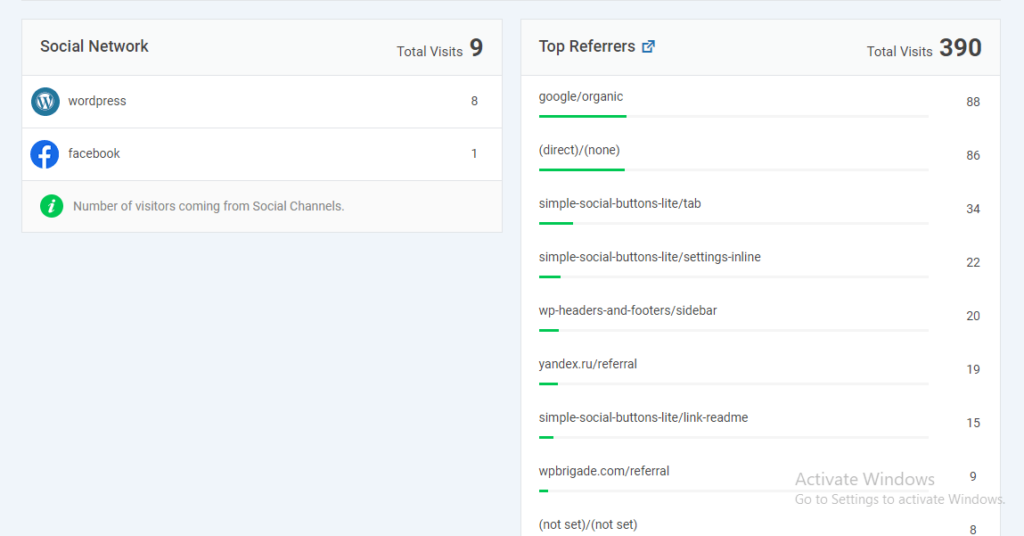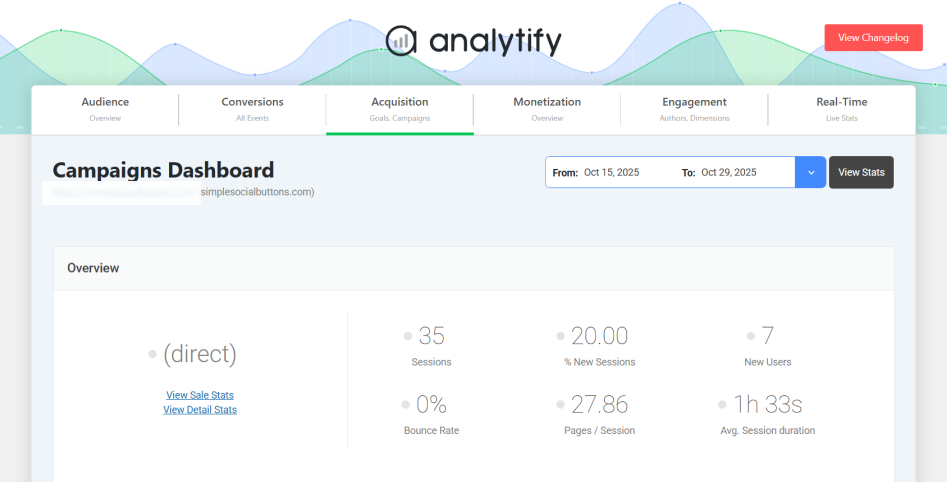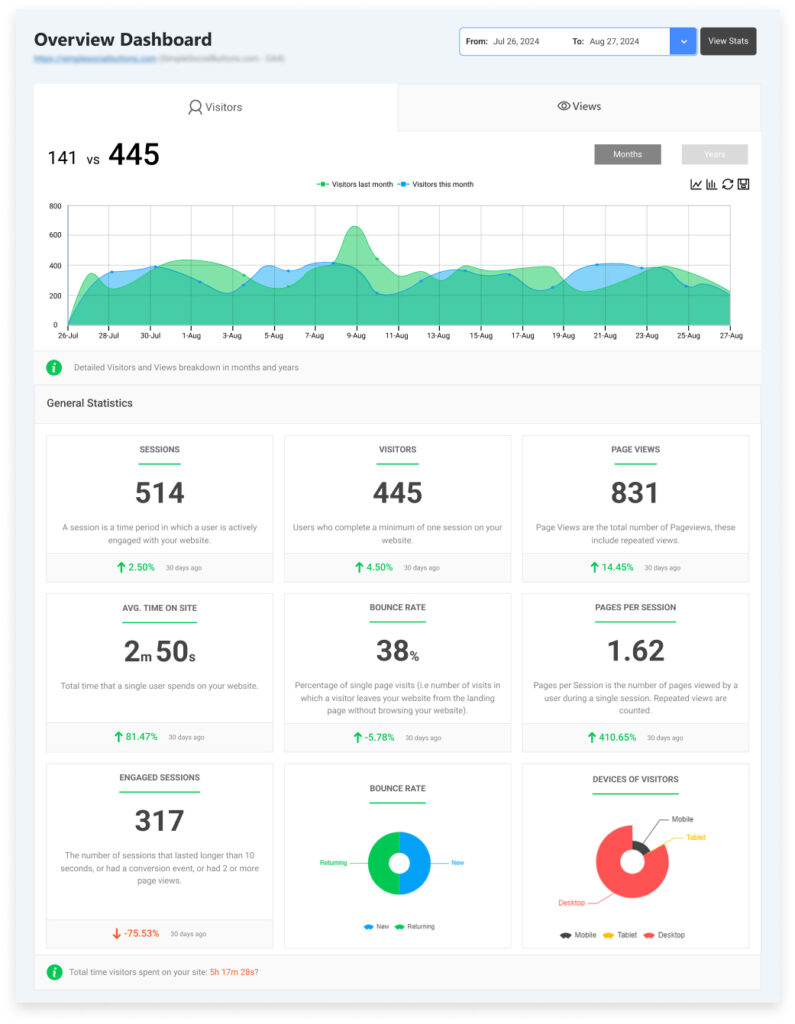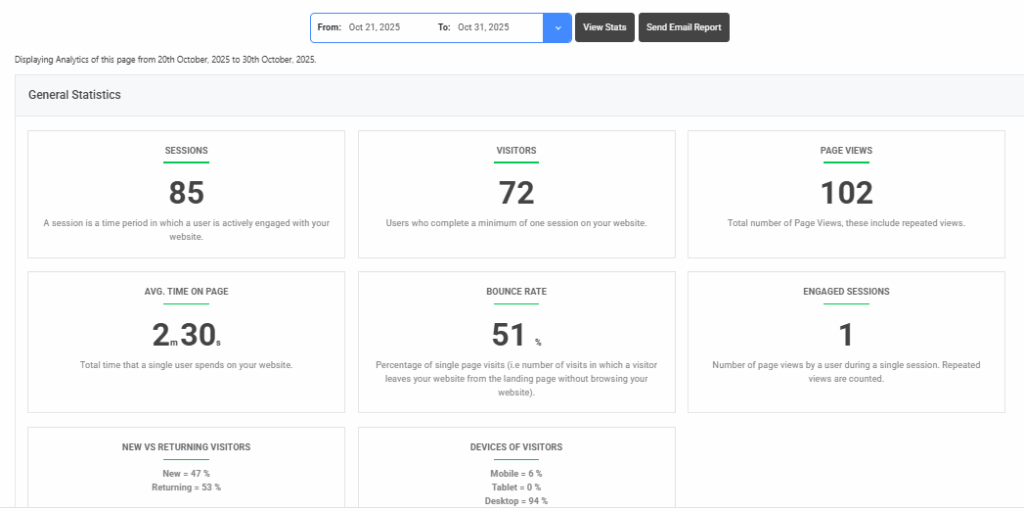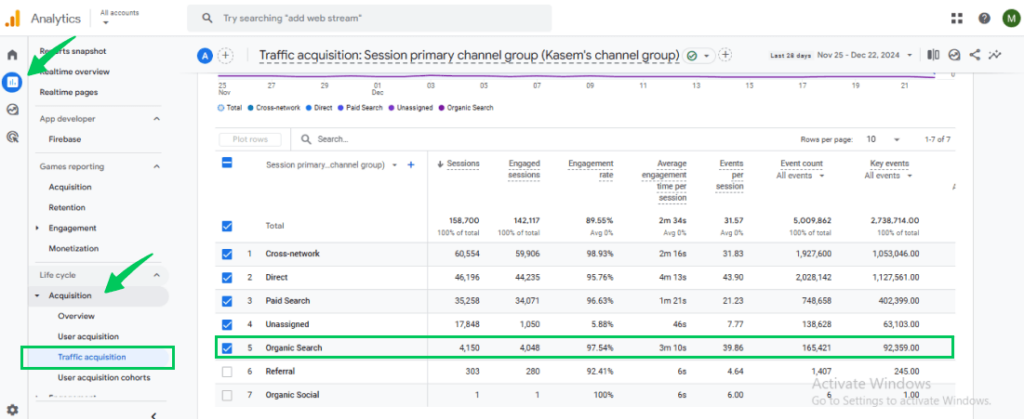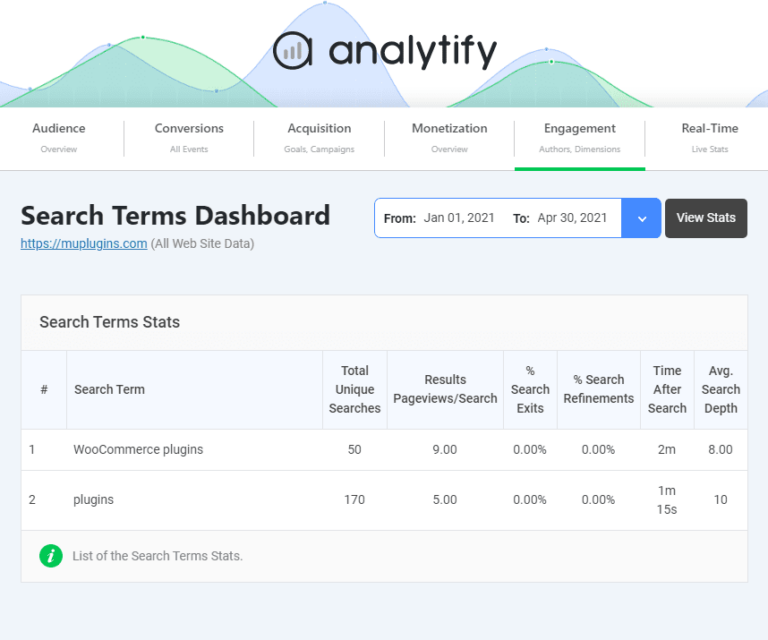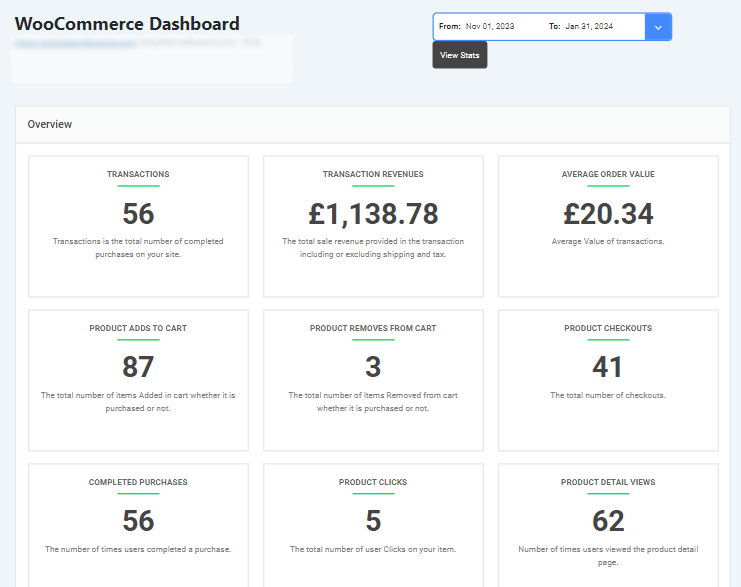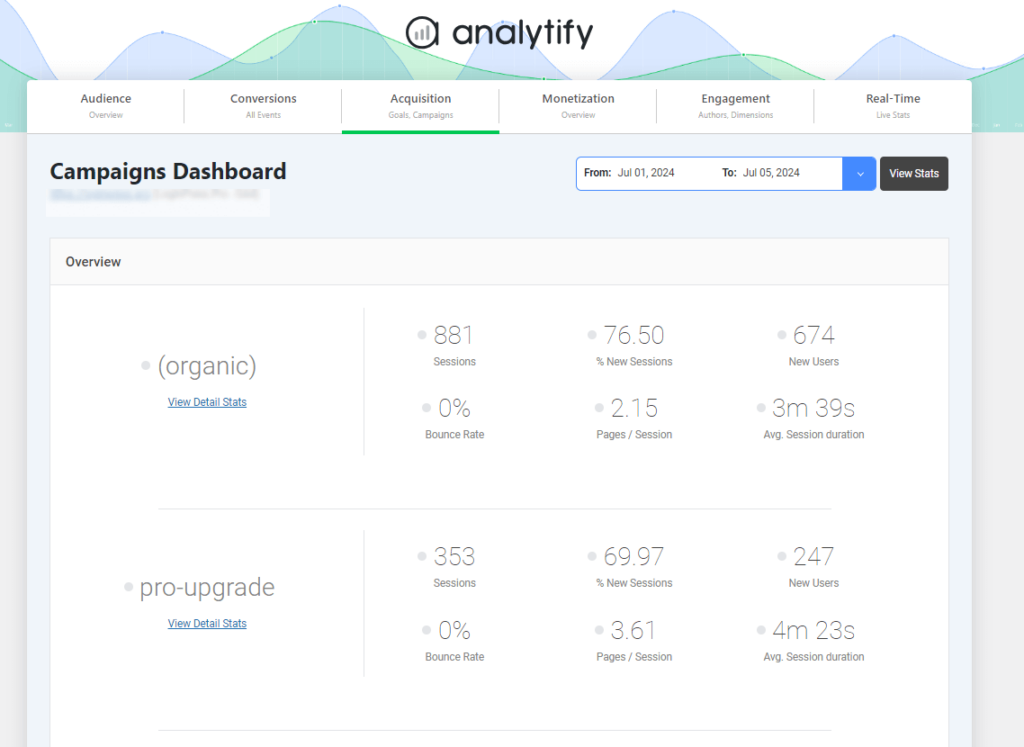
11 Powerful Organic Growth Business Strategies to Boost Your Business
Organic growth business strategies are the secret behind brands that grow faster, spend less, and build loyal audiences that keep coming back.
Growing a business doesn’t always mean spending more on ads. Real, lasting growth comes from the inside. When your customers keep coming back, your content reaches the right people, and your brand becomes a trusted name in its space.
That’s what organic growth is all about. It’s not fast or flashy, but it’s steady, reliable, and far more sustainable. Instead of chasing short-term results, organic growth builds a strong foundation that keeps your business moving forward, even when the market shifts.
With organic growth business strategies, you focus on what actually matters to your customers, your content, and your performance. And when you track all of it with the best Google Analytics plugin, Analytify, you can see exactly what’s working and where to improve, right inside WordPress.
In this guide, I’ll break down what organic growth strategy in marketing really means, why it should be part of every business plan, and 11 practical strategies to help your business grow naturally, backed by real analytics.
Organic Growth Business Strategies (TOC):
What Is Organic Growth?
Organic growth means expanding your business using the resources you already have, such as your products, your customers, and your content. It’s about attracting people naturally through trust and value, rather than paying for quick visibility.
Think of it like growing a plant. You water it, care for it, and let it grow at its own pace. The roots get stronger over time, just like your business does when you focus on customer relationships, helpful content, and consistent service.
This kind of growth happens when your current customers keep coming back, tell others about you, and help spread the word. It’s also when new people find your business through search engines, social media, or recommendations, not ads.
In contrast, inorganic growth comes from outside forces like paid advertising or mergers and acquisitions. It can be faster, but often costs more and doesn’t always lead to long-term loyalty.
Every organic growth business strategy works best when backed by data. You need to know what’s helping your business grow and what’s holding it back. That’s where Analytify comes in. It makes tracking easy by showing key insights like traffic sources, user behavior, and top-performing content right inside WordPress. This helps you focus on what’s really working, without guessing.
Why Organic Growth Should Be a Long-Term Business Strategy
Organic growth doesn’t happen overnight, and that’s what makes it powerful. It’s built on trust, consistency, and real connections with your audience. When you grow this way, your business becomes stronger, more stable, and less dependent on ads or sudden trends.
A big reason to focus on organic growth is trust. People are more likely to buy from brands they’ve seen, read about, or heard recommended by others. When your content answers their questions and your product delivers real value, they remember you and come back.
Another advantage is compounding results. The blog post you publish today can keep bringing traffic months or even years from now. Loyal customers can turn into brand advocates who refer new people without any extra marketing spend. Over time, your growth builds on itself.
But to keep this momentum, you need to stay data-driven. You can’t improve what you don’t measure. That’s why tracking tools like Google Analytics and Analytify, the best WordPress plugin, matter. It shows you which channels drive repeat visitors, which pages bring in organic traffic, and how people engage with your site. These insights help you make smart, long-term decisions, not just short-term fixes.
Organic growth marketing should be steady, reliable, and built to last. And when guided by clear analytics, it becomes one of the most cost-effective ways to grow any business.
11 Best Organic Growth Business Strategies
Growing a business organically takes patience, consistency, and the right tools. Here are 11 powerful organic growth business strategies that can help you attract more customers, build trust, and create long-term success.
Strategy #1: Leverage Existing Customers for Repeat Revenue
One of the fastest ways to grow organically is to focus on the people who already know and trust your brand. Your current customers cost less to reach, convert more easily, and often spend more over time. Instead of chasing new leads every month, start by deepening relationships with existing ones.
Encourage repeat business through loyalty programs, exclusive updates, and personalized recommendations. A simple thank-you email or early access to new features can remind customers why they chose your brand in the first place. The goal is to turn one-time buyers into long-term supporters who return regularly and advocate for your products.
To make this work, you need to understand how returning customers behave on your site. That’s where Analytify helps.
Join 50,000+ beginners & professionals who use Analytify to simplify their Google Analytics!
Its Returning Visitors Report shows how often people come back, which pages they revisit, and how their engagement changes over time. You can also monitor conversion behavior to see what encourages them to take action again.
For example, if you notice that users who read a certain blog post or visit a pricing page return more frequently, that’s a signal to strengthen those touchpoints. By tracking repeat user activity through Analytify, you can identify patterns that lead to retention and adjust your strategy to encourage more of it.
Organic growth starts with loyalty.
Strategy #2: Build a Referral and Advocacy Program
Referrals are one of the most powerful organic business growth strategies because they combine trust with reach. People are far more likely to try a brand when it’s recommended by someone they know. A strong referral or advocacy program turns satisfied customers into active promoters.
Start by creating an easy system where customers can share your products or services with friends. Offer small rewards or discounts as a thank-you, but keep the focus on genuine value. People refer brands that deliver great experiences, not just incentives. You can also build advocacy through user-generated content, testimonials, or community shoutouts.
Once your program is running, tracking its performance is essential. Analytify makes this simple by showing referral traffic right inside your WordPress dashboard. You can see which channels send visitors, how those visitors behave, and which referrals convert into paying customers.
For instance, if you’re collaborating with partners or influencers, Analytify’s Campaign Tracking feature helps you measure which sources bring high-quality traffic. You’ll know exactly which advocates or content types drive real results.
A well-built referral system doesn’t just bring new customers. It builds a network of loyal supporters who help your brand grow naturally. By pairing that strategy with accurate analytics from Analytify, you can refine, measure, and scale your advocacy efforts with confidence.
Strategy #3: Invest in Email Marketing
Email marketing remains one of the most effective organic growth strategies in business because it reaches people who have already expressed interest in your brand. Unlike social media posts that compete for attention in crowded feeds, emails land directly in your subscribers’ inboxes, where they choose to engage with your message.
Email consistently outperforms many other marketing channels in driving engagement and sales. Businesses often see strong returns because it directly connects with an audience that has already opted in, making every message highly relevant and impactful.
To get started, choose a reliable email marketing platform that suits your business, such as Mailchimp, ConvertKit, or Drip. Build a clean, permission-based email list and create compelling opt-in forms to encourage subscriptions. Segment your audience by behavior, purchase history, or engagement level to ensure every email feels relevant and personal.
Focus on providing value in every email. Share tips, updates, tutorials, or special offers that genuinely help your subscribers. Avoid sending overly promotional messages, which can lead to unsubscribes. Instead, aim to build long-term relationships by nurturing trust and demonstrating your expertise.
Here’s where Analytify comes in: track every email campaign directly from your WordPress dashboard. See which newsletters generate the most clicks, which links drive traffic to your website, and which campaigns convert into sales. You can also analyze subscriber behavior over time to refine your content and improve engagement.
Experiment with A/B testing subject lines, content formats, and send times, and use Analytify’s reporting to understand what works best. Over time, a data-driven email marketing approach not only boosts repeat sales and engagement but also strengthens customer loyalty.
Strategy #4: Create Search‑Driven Content (SEO + Blogging)
One of the most powerful organic growth business strategies is publishing content that aligns with what your audience is actively searching for. By creating blog posts, guides, and resources that solve real‑world problems, you build a lasting inbound traffic stream rather than relying solely on paid promotion.
Here’s how it works!
When you publish helpful, search‑friendly content, you’re effectively earning your traffic through relevance and value. This kind of content can continue to attract visitors long after it’s published (a “long tail” effect), driving brand authority and engagement over time.
According to recent data:
- The average click‑through rate (CTR) for blog posts across industries is about 2.00%, with a range from ~0.77% up to ~4.36%.
Let’s See How to Do It (Step‑by‑Step)
- Identify search intent and topics: Use keyword research tools (Google Keyword Planner, Ahrefs, SEMrush) to find queries your target audience is using. Focus on “how to”, “best practice”, “compare”, and “guide” forms. These are often intent‑rich and relevant.
- Create in‑depth, helpful content: Rather than superficial “10 quick tips” pieces, go deep. Provide real examples, data, screenshots (if relevant), and actionable takeaways. This builds trust and engagement.
- Structure for SEO and readability: Use a clear H1/H2/H3 structure, include target keywords naturally, optimize meta titles and descriptions, ensure fast load speed, and mobile‑readiness.
- Publish and promote smartly: Once live, share the content through social channels, email newsletters, and community groups. Encourage internal linking from other pages, and external linking if possible.
- Monitor and optimise: After publishing, use Analytify, the best GA4 plugin for WordPress, to track organic sessions, bounce rate, time on page, traffic sources, and conversions from that content. See which posts attract visitors and where you might improve or update.
- For example, if a blog post attracts lots of organic traffic but the bounce rate is high, you might update it with better internal links, richer visuals, or clearer CTAs.
- If a post drives steady traffic but few conversions, you can experiment by adding a relevant lead magnet or aligning it with a product/service page.
Strategy #5: Optimize for Organic Search
Optimising your website for organic search remains one of the most dependable organic growth business strategies. While content attracts traffic, SEO ensures your content and site are visible, accessible, and relevant to those searchers.
The first organic search result alone can capture around 27–30% of clicks, underscoring just how valuable high ranking is.
This tells us that if you ignore SEO, you risk missing out on the bulk of discoverability. But done right, it’s a long‑term growth engine.
Let’s See How to Do It (Step‑by‑Step)
- Audit your technical foundations: Ensure your site loads fast, is mobile responsive, uses HTTPS, has a clear site structure (menus, internal links), and resolves crawl errors.
- Keyword and intent alignment: Use keyword research to identify terms your audience searches for, and map them to content pages. But go beyond keywords: focus on search intent (informational, navigational, transactional) to match what users are really doing.
- On‑page optimisation: For each page, use descriptive titles, meta descriptions, headers (H1/H2), descriptive alt tags for images, structured data markup (schema) where relevant, and ensure your primary keyword appears naturally.
- Content depth and freshness: Create substantial articles or pages (many top‑ranking pages now exceed 1,500–2,000 words) that answer user questions, use visuals, multimedia, case examples, and update them regularly.
- Link authority and internal linking: Build internal links between your pages to spread authority and gain external high‑quality backlinks from relevant, trusted sites.
- Track and optimise continuously: Here’s where Analytify adds major value:
- Monitor organic sessions, bounce rate, exit page,s and conversions on pages you’ve optimised.
- Use the report data to identify pages with good traffic but low conversions ( optimise calls‑to‑action) or pages with poor traffic (refine content or keywords).
- Track keyword trends (if integrated) or use UTM tagging and landing page tracking to see keyword‑driven performance over time.
- Adapt to new search formats: In 2025, SEO isn’t just about the “10 blue links” anymore. With AI‑driven search features, rich snippets, and zero‑click behaviour taking hold, make sure your content is structured ( FAQs, schema markup ), fast, and authoritative.
Strategy #6: Engage Through Community Building
Building and nurturing a community around your brand is one of the most effective organic growth business strategies because it transforms customer relationships into two‑way conversations, trust networks, and loyal advocacy hubs.
In 2025, over 76% of internet users are active in online communities, forums, groups, and social hubs, making community‑based engagement a robust channel for organic growth.
Because community members often become brand advocates, referral traffic, shared user‑generated conten,t and deeper engagement become self‑reinforcing growth signals.
How to Do It (Step‑by‑Step)
- Identify where your audience already is: Whether it’s Facebook Groups, LinkedIn forums, Slack/Discord channels, or a dedicated sub‑forum on your site. Choose platforms where your target users congregate and feel comfortable.
- Create a branded “home” for the community: This could be a private group, a forum, a members‑only area in your website or app. Make it feel exclusive yet welcoming.
- Seed meaningful conversation: Launch with discussion prompts: ask questions, run polls, share insights or tips, invite feedback. Make sure your brand is present but not dominating.
- Encourage user‑generated content and peer interaction: Invite members to share their experiences, problems, wins; feature their stories. This builds authenticity and offloads some of the content creation burden.
- Track and refine:
- Create custom segments in GA4 for traffic coming from community platforms (e.g., Slack, Discord, Facebook group links) and measure how those visitors engage (session length, returning visits, conversions).
- Track posts or pages where community‑driven links land, compare bounce rates, time on page, and conversion rates vs ordinary traffic.
- Use behavior reports from Analytify to spot patterns: do community visitors spend more time, convert better, refer new users? Use these insights to amplify what works.
- Create custom segments in GA4 for traffic coming from community platforms (e.g., Slack, Discord, Facebook group links) and measure how those visitors engage (session length, returning visits, conversions).
- Reward and recognise engagement: Highlight top contributors, run challenges, gamify participation, offer early access, or special perks. This deepens loyalty and gives people a reason to stay active.
Strategy #7: Deliver Exceptional Customer Experience
Customer experience (CX) is a cornerstone of sustainable organic growth business strategies. Happy customers not only return but also recommend your business, creating a self-reinforcing growth loop.
80% of consumers say they would switch brands after a bad experience, while a positive experience increases loyalty and referral likelihood.
Let’s See How to Do It (Step‑by‑Step)
- Map the customer journey:Identify every touchpoint, from website visits and sign-ups to post-purchase interactions. Understand where customers experience friction.
- Gather feedback systematically: Use surveys, NPS, and support interactions to pinpoint gaps and opportunities.
- Optimize support channels: Fast response, multiple support options (chat, email, social), and proactive problem-solving increase satisfaction.
- Personalize experiences: Recommendations, tailored content, and custom offers make customers feel valued.
- Use Analytify to track engagement and behavior:
- Monitor repeat visits, session duration, and page interactions to see how users engage with your content or products.
- Track conversion events like purchases, form submissions, or downloads to identify high-value touchpoints.
- Segment customers by behavior (repeat visitors, high-value buyers) to prioritize experience improvements.
- Monitor repeat visits, session duration, and page interactions to see how users engage with your content or products.
Strategy #8: Innovate Your Offerings
Innovation is another key organic growth strategy. Improving or diversifying your products and services based on customer needs keeps your business relevant, attracts new users, and strengthens loyalty.
Businesses that innovate see higher growth rates; companies that fail to innovate risk stagnation and losing market share.
Let’s See How to Do It (Step‑by‑Step)
- Collect insights from data: Use analytics to see which features, products, or content resonate most with users.
- Solicit customer input: Feedback forms, surveys, beta testing, and early access programs help identify what innovations customers want.
- Test new ideas incrementally: Pilot new features or products before rolling out fully to minimize risk.
- Measure impact with GA4 and Analytify:
- Track engagement metrics for new features or content.
- Monitor conversion rates for newly launched offerings.
- Compare traffic, session duration, and repeat interactions before and after changes to see the effect of innovations.
- Track engagement metrics for new features or content.
Strategy #9: Improve Operational Efficiency
Improving operational efficiency is one of the most overlooked organic growth business strategies. When your business runs smoothly, with fewer bottlenecks, faster workflows, and clearer data, you reduce costs and free up resources to invest in growth.
Let’s See How to Do It (Step-by-Step)
- Audit your workflows: Identify manual, repetitive tasks that can be automated (e.g., reporting, order processing, follow-ups).
- Integrate analytics early: With Analytify, you can monitor key performance indicators (KPIs) that reveal inefficiencies like slow pages, underperforming campaigns, or high bounce rates.
- Track employee or process performance metrics:For instance, use Analytify to analyze how site changes impact conversions or user engagement time, indicating whether internal improvements are working.
- Review and refine regularly: Efficiency isn’t a one-time fix; it’s a culture. Set quarterly reviews using data from Analytify and other tools to evaluate outcomes and adjust.
Strategy #10: Form Strategic Partnerships
Strategic partnerships can dramatically accelerate your organic growth strategy by opening access to new audiences, resources, and expertise, all without heavy spending.
Strategic collaborations build credibility fast because audiences trust established brands recommending you.
Let’s See How to Do It (Step-by-Step)
- Identify complementary partners: Look for brands that share your target audience but aren’t direct competitors (e.g., a plugin that integrates with yours, or a business in a related niche).
- Define mutual goals: Whether it’s co-branding content, running webinars, or launching bundled offers, make sure both sides benefit.
- Collaborate on organic initiatives: Share blog content, referral links, or community shoutouts to grow awareness without paid ads.
- Track partnership performance with Analytify:
Use UTM parameters on referral links to track traffic from partners.
- Analyze conversions, session duration, and engagement of visitors coming from partner domains.
- Identify which partnerships drive the most valuable users who engage and convert.
- Nurture and expand successful collaborations: Keep the momentum going with ongoing campaigns, joint updates, or affiliate arrangements.
Strategy #11: Strengthen Brand and Thought Leadership
Establishing your brand as an authority in your niche is a powerful organic growth business strategy. Thought leadership builds trust, attracts an audience organically, and encourages referrals and conversions without heavy ad spend.
Brands that consistently publish authoritative content see 3–4x higher engagement rates than those that do not.
Let’s See How to Do It (Step‑by‑Step)
- Identify your niche expertise: Focus on topics your audience values most and where you have unique insights. This could be product knowledge, industry trends, or case studies.
- Publish high-quality content consistently: Blogs, guides, whitepapers, podcasts, webinars, or videos that showcase your expertise help attract and retain an audience.
- Engage on relevant platforms: Share your insights on LinkedIn, industry forums, guest blogs, and social communities to expand reach and authority.
- Leverage Analytify to measure impact:
- Track which thought leadership content drives the most organic traffic, engagement, and conversions.
- Measure repeat visits and average session duration to see how authoritative content keeps users engaged.
- Track which thought leadership content drives the most organic traffic, engagement, and conversions.
Best Practices for Organic Growth
- Track metrics monthly and review quarterly to assess overall growth.
- Compare performance across strategies to identify high-impact actions.
- Use insights from Analytify to optimize campaigns, update content, and refine customer engagement strategies.
By systematically measuring and monitoring your organic growth, you ensure your business grows sustainably, efficiently, and in a data-driven way. Analytify transforms raw analytics into actionable insights, helping you make smarter decisions that maximize long-term results.
Common Pitfalls to Avoid While Creating Organic Growth Strategies
While organic growth business strategies are highly effective, businesses often stumble in ways that slow progress or waste resources. Avoiding these pitfalls ensures your growth efforts deliver sustainable results.
- Trying Every Tactic at Once
- It’s tempting to implement all strategies simultaneously, but spreading resources too thin reduces effectiveness. Focus on a few strategies at a time, measure results, then expand gradually.
- It’s tempting to implement all strategies simultaneously, but spreading resources too thin reduces effectiveness. Focus on a few strategies at a time, measure results, then expand gradually.
- Relying on Assumptions Instead of Data
- Guesswork leads to wasted effort. Use analytics tools like Analytify to validate decisions, track performance, and understand what’s actually driving growth.
- Guesswork leads to wasted effort. Use analytics tools like Analytify to validate decisions, track performance, and understand what’s actually driving growth.
- Expecting Quick Results
- Organic growth takes time. SEO, content marketing, community building, and relationship-driven strategies compound over months. Patience and consistency are key.
- Organic growth takes time. SEO, content marketing, community building, and relationship-driven strategies compound over months. Patience and consistency are key.
- Neglecting Customer Experience
- Growth isn’t just about traffic; it’s about retention. Ignoring feedback, slow support, or a poor user experience can undo gains from other strategies. Always track engagement and satisfaction metrics in Analytify.
- Growth isn’t just about traffic; it’s about retention. Ignoring feedback, slow support, or a poor user experience can undo gains from other strategies. Always track engagement and satisfaction metrics in Analytify.
- Ignoring Optimization and Iteration
- Even successful strategies require continuous improvement. Use performance reports, A/B testing, and regular audits to refine your approach and amplify what works.
- Even successful strategies require continuous improvement. Use performance reports, A/B testing, and regular audits to refine your approach and amplify what works.
By avoiding these common pitfalls and combining disciplined execution with analytics-driven insights, businesses can achieve long-term, sustainable organic growth.
Organic Growth Business Strategies FAQs
1. What is organic growth vs. paid growth?
Organic growth comes from natural, unpaid sources like content marketing, SEO, referrals, and community engagement. Paid growth relies on advertisements or sponsored campaigns to drive traffic and conversions. Organic growth tends to be slower but more sustainable and cost-effective long-term.
2. How long does organic growth take?
Results vary by industry, audience, and strategy, but most businesses see meaningful improvements in 3–6 months for content and SEO, while strategies like email marketing and community engagement compound over time. Patience and consistency are essential.
3. Can a small business rely only on organic growth?
Yes. Many small businesses grow effectively using organic strategies alone, especially when budgets are limited. Combining SEO, content marketing, email, and customer advocacy often produces strong, sustainable results.
4. What metrics should I track to measure organic growth?
Key metrics include organic sessions, returning users, conversion rates, referral traffic, engagement (time on site, bounce rate), and campaign performance. Tracking these helps you see which strategies work best.
5. How can analytics tools like Analytify help improve organic strategies?
Analytify provides clear dashboards and reports within WordPress, showing organic traffic, user behavior, conversions, and referral sources. This data allows businesses to make informed decisions, optimize campaigns, and measure ROI effectively.
Organic Growth Business Strategies: Recap
Sustainable organic growth business strategies are essential for building long-term success. By focusing on customer loyalty, content, community, SEO, and innovation, businesses can grow their audience, strengthen trust, and increase revenue without relying solely on paid advertising.
Tracking performance is equally important. Tools like Google Analytics 4 and Analytify allow you to measure organic traffic, user engagement, conversions, and referral sources. It helps you in turning insights into actionable improvements. From email campaigns and SEO optimization to community building and strategic partnerships, every strategy benefits from a data-driven approach.
Organic growth is not a quick fix; it compounds over time. Businesses that implement these strategies consistently, analyze results, and refine their tactics are better positioned to thrive in competitive markets. By combining these organic growth strategies in marketing with actionable analytics, you can grow smarter, build lasting relationships, and create a resilient, high-performing business.
You may also like to read:
- Top 20 Marketing Hacks for Website Traffic Growth
- How To Use Google Analytics To Increase Traffic (10 Ways)
Now, I’d love to hear from you. Which organic growth strategy did you find the best fit in your case? Share your thoughts below in the comments.

